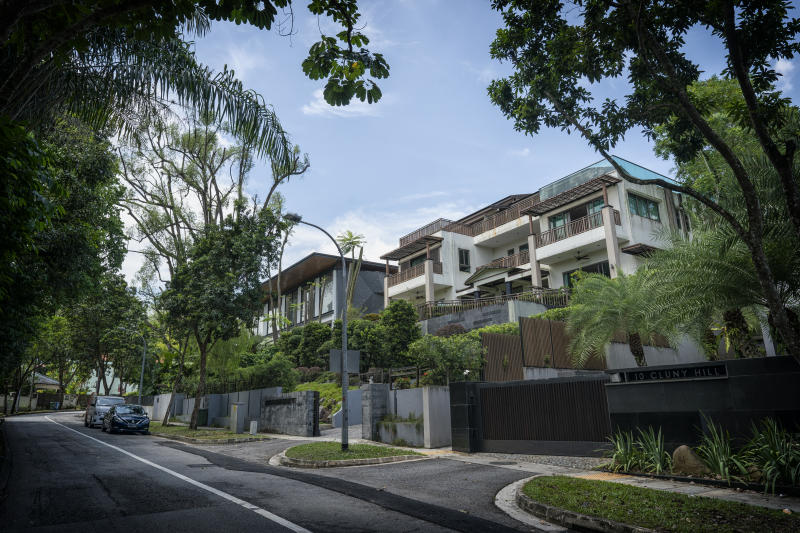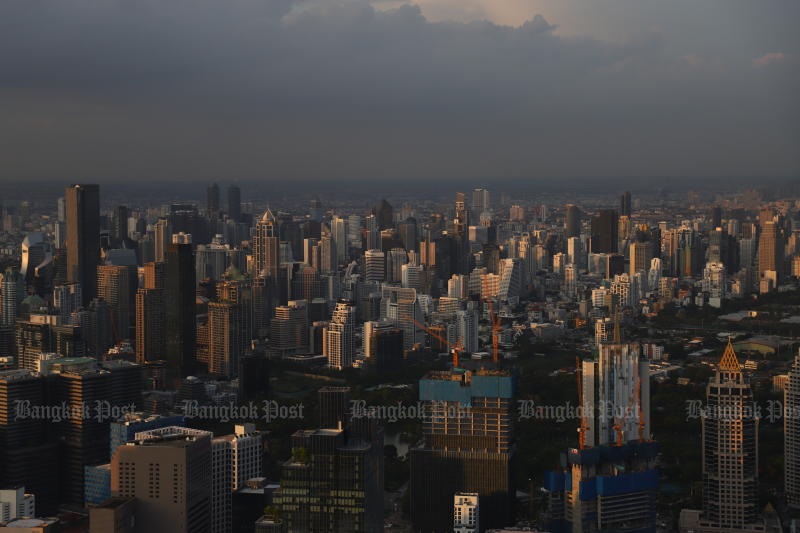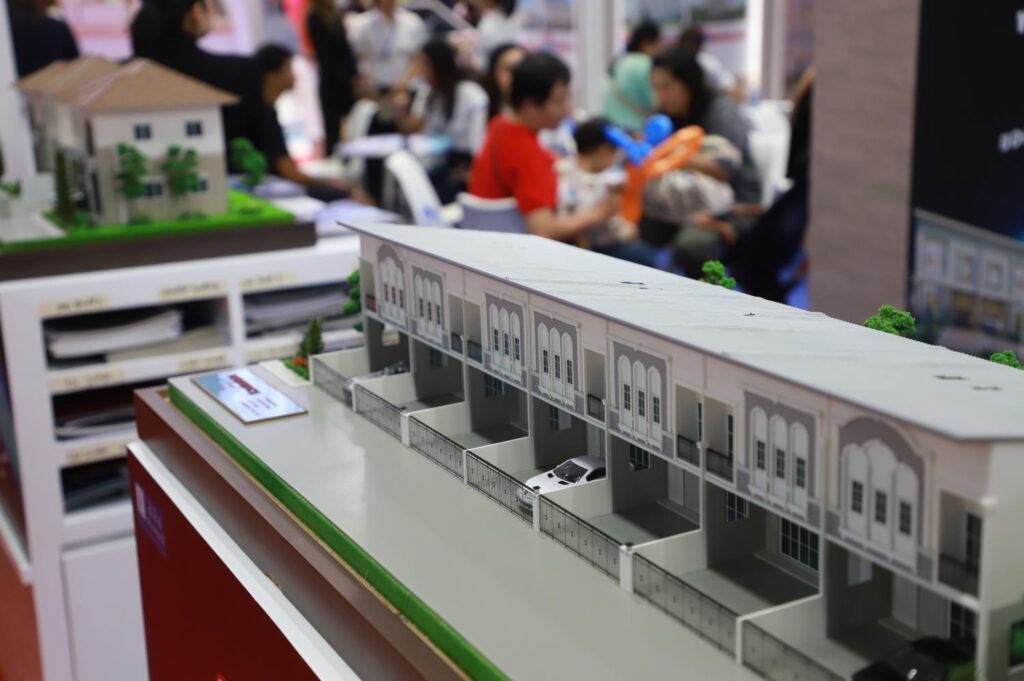Singapore private home prices rose at a slower pace in the first quarter, underscoring a cooling of a market that had shown renewed interest in new projects but also signaling a complex balance between demand, supply, and policy measures as the city-state heads toward national elections. The Urban Redevelopment Authority’s preliminary data show a modest 0.6% quarter-on-quarter gain in private residential prices, marking a notable slowdown from the previous quarter’s 2.3% increase. The softer pace in price growth, coming after a period of hot demand for new launches, suggests a more tempered market mood even as activity remains substantial in certain segments. The data are preliminary and reflect performance up to mid-March, with final house price and transaction figures for the first quarter slated for release later in April. These numbers are part of a broader narrative about Singapore’s housing dynamics, where price momentum has eased even as affordability and supply remain central concerns for policymakers, buyers, and developers alike.
URA Q1 Private Residential Price Index: A Comprehensive Snapshot
The Urban Redevelopment Authority (URA) provides a quarterly snapshot of private residential prices that encompasses condominiums and other private housing categories. The latest preliminary index indicates a 0.6% increase from the prior quarter, a figure analysts described as mildly surprising given the recent surge in interest for new launches. The 0.6% gain sits in contrast to a more pronounced 2.3% jump in the fourth quarter of 2024, highlighting a deceleration in price velocity after a period of stronger momentum. This slower growth pace is being watched by investors and buyers who had anticipated a more robust uplift following the renewed appetite for new private projects.
Analysts point to several factors behind the moderation. One possibility cited is a softening in price growth for second-hand private homes, which may have contributed to the subdued quarter-on-quarter gains. The interplay between new-launch demand and secondary market pricing can influence overall private home indices, particularly in a market where buyers often weigh the relative value of newly launched units against existing stock. The URA index itself is a comprehensive barometer of price movements across Singapore’s private residential sector, reflecting changes across multiple subsegments and locations. In the current environment, the index’s pace matters for expectations about future supply deployment, pricing strategies by developers, and the rate at which buyers adjust their budgets in response to market signals.
The data release also notes that private home transactions declined meaningfully on a quarterly basis, by roughly 15% when compared with the previous quarter. It’s important to recognize that the transaction figure captured by the URA is a snapshot up to mid-March, and the final quarterly tally will be released on the specified date later in April. The combination of a modest price uptick and a sharper fall in transactions paints a picture of a market that remains active but more selective, with buyers perhaps waiting for clearer signals on prices, interest rates, and policy directions before committing to large purchases. The relationship between price changes and transactional activity remains a central theme for market watchers who track how sentiment and affordability interact with supply constraints and policy measures.
Within this framework, private home prices can be influenced by a range of forces, including the performance of new-launch units, demand for suburban versus central locations, and shifts in financing conditions. The URA data are also interpreted in the context of government policy, where authorities have emphasized the importance of maintaining a stable supply of housing to meet buyer needs, even as they monitor price developments. While the first-quarter figures show a softer pace, the broader narrative remains that price momentum is not collapsing, but does appear to be moderating in alignment with a measured approach to market management. As final quarterly results are published, analysts will re-evaluate the degree to which the uptick in new launches translates into price dynamics across both primary and secondary markets.
Demand and Supply Dynamics: Suburban New Homes and Buyer Behavior
In recent months, a notable shift has emerged in buyers’ preferences within Singapore’s property landscape. A growing cohort of purchasers has gravitated toward new homes in suburban districts. This shift reflects a combination of favorable financing conditions, the appeal of newer designs and amenities, and a perceived opportunity to secure value through capital appreciation as supply in outlying areas expands. Some buyers are drawn to the prospect of locking in lower financing costs and potentially realizing quick profits through property flipping in a market where pricing can swing with sentiment and policy signals.
Developers, in response, have become more aggressive in acquiring suburban land in anticipation of continued demand in these areas. One land parcel near the eastern beachfront ignited strong competitive bidding, drawing eight bids from multiple developers. This bidding fervor indicates sustained interest in suburban sites that offer favorable fundamentals, including proximity to transportation, amenities, and potential for growth in rental income. The parallel trend of strong new-launch activity in suburban neighborhoods complements the price dynamics observed in the private market, underscoring a bifurcated landscape where urban core prices may diverge from suburban trajectories while overall market liquidity remains alive.
The divergence in demand patterns has several implications. For buyers, the appeal of suburban new-builds often hinges on perceived value, longer-term capital appreciation, and the ability to secure units with modern layouts and updated features. For developers and investors, suburban land acquisitions represent strategic bets on evolving demographics, improved infrastructure, and the potential for better project margins in lower-density environments. These dynamics also influence the rhythm of property launches, pricing strategies, and the pace at which new projects enter the market, contributing to a diverse array of offerings for different buyer segments.
In the context of the broader market, the suburban shift interacts with rates and borrowing conditions. Lower interest rates can support higher loan affordability, enabling buyers to stretch budgets for newer, more spacious units in suburban districts. Conversely, if rates rise or borrowing costs increase, demand for such projects could cool, even as supply remains robust. The interplay of these factors helps explain why price growth may moderate even as activity remains active, particularly in segments linked to new launches and suburban developments. As buyers weigh options across central and suburban markets, developers’ strategies and land-banking decisions will continue to shape the pipeline of upcoming projects and the pricing of new units.
Market Sentiment and Policy Signals: Protection, Moderation, and Intervention
Market sentiment in Singapore’s housing sector has been shaped not only by market indicators but also by expectations of policy action. Analysts from major financial institutions have highlighted the potential for government intervention if property prices rise too quickly. The concern is not solely about price levels but about the speed and pace of increases that could outpace affordability for a broad base of buyers. While intervention signals can dampen enthusiasm in the short term, they are often viewed as a mechanism to stabilize the market and prevent overheating, preserving long-term affordability and systemic stability.
Against this backdrop, National Development Minister Desmond Lee has publicly framed the market as showing early signs of moderation in price growth across both public and private housing segments. In a social media post, he stressed the government’s commitment to maintaining a strong housing supply that aligns with homebuyers’ needs. This emphasis on supply is consistent with a policy approach that seeks to balance price dynamics with accessibility, ensuring that the housing market remains functional and sustainable even as demand fluctuates. The minister’s commentary suggests that policymakers are watching the data closely and are prepared to respond with supply-side measures or other policy tools if price momentum becomes misaligned with affordability objectives.
The policy environment in Singapore has historically included deliberate steps to curb price surges, particularly in the private market. This year has seen multiple rounds of curbs aimed at dampening speculative activity and ensuring prudent price formation. Measures have included efforts to bolster housing supply and adjustments to the tax framework affecting non-resident purchases of private homes. In Singapore, foreign buyer taxes have been a key instrument in tempering demand from abroad, with significant implications for pricing dynamics and ownership structures. These policy levers interact with market sentiment, shaping expectations around both the level and trajectory of prices.
Analysts from global banks have also flagged the potential for macroprudential actions or policy recalibrations if price gains accelerate. The broader conclusion drawn by many observers is that while prices may ease in the near term due to moderation in momentum, policymakers remain vigilant to ensure supply continues to meet demand and that price growth remains aligned with long-term affordability and social objectives. This delicate balance between market dynamics and regulatory oversight continues to define Singapore’s housing landscape, with stakeholders monitoring quarterly data for any signals of shifts in prices, transactions, and supply conditions.
Public vs Private Housing: Price Trajectories and Interconnectedness
A separate estimate released on the same day shows second-hand public housing prices rising by 1.5% quarter-on-quarter, compared with a 2.6% jump in the prior quarter. This contrast between public and private housing price movements is notable, as shifts in private market prices tend to move in tandem with government-built housing prices. The relationship between the two sectors often reflects broader macroeconomic rhythms, including financing conditions, wage growth, and consumer sentiment, all of which influence how households allocate budgets between private ownership and subsidized public housing options.
Even with the moderation in private price growth, the sector remains buoyant on a year-on-year basis, with private home prices up 3.1% from a year earlier. This year-on-year increase indicates that, while momentum has cooled on a quarterly basis, the cumulative gains over the past year still point to a price level higher than a year ago. The interplay between the private and public housing segments remains a critical focal point for policymakers, developers, and buyers as they navigate affordability concerns, supply constraints, and the budgetary realities facing households across income levels.
The ongoing moderation in price growth does not imply a wholesale correction. Instead, it suggests a recalibration of market dynamics after a period of intense activity. Buyers continue to engage with the market, particularly for newer units and those positioned in growing neighborhoods. The public housing framework remains a backbone of Singapore’s housing system, offering stability and affordability for a large portion of the population, while private housing provides options for those seeking different features, locations, and investment profiles.
Year-on-Year Trajectory, Affordability, and Social Considerations
Looking at the year-on-year comparison, private home prices have risen by 3.1%, despite the more muted quarterly pace. This YoY figure underscores that prices are still elevated relative to a year ago, even as the quarterly momentum softens. For policymakers and the public, affordability continues to be a central issue, particularly given Singapore’s dense urban environment, high demand, and ongoing efforts to balance growth with living standards. The momentum seen over the year may reflect structural factors, including demand for new launches, the appeal of contemporary designs, and the perceived value of real estate as an asset class in a low-yield environment.
The affordability conversation remains closely tied to policy actions and market responses to them. The rounds of curbs implemented in recent years reflect a deliberate attempt to curb speculative demand and to curb price trajectories that would jeopardize the ability of residents to enter the market. The 60% tax rate on most foreign purchases of private homes is cited as one of the more aggressive measures in the world, designed to dampen non-resident demand and to maintain a healthier balance between supply and demand. These policy instruments have a direct bearing on price dynamics, investor behavior, and the accessibility of homes for locals, including first-time buyers and middle-income households.
In this context, the overall longer-term outlook for private housing remains contingent on a combination of supply growth, price moderation, and the trajectory of interest rates. Lower borrowing costs, for instance, can support higher price levels by expanding affordable purchase options. Conversely, if policy measures further tighten demand or if financing costs rise, price momentum could slow further, potentially nudging buyers toward different segments or locations. The year-over-year trend thus captures both the resilience of price levels and the sensitivity to shifting market conditions and policy signals.
Policy Context: Curbs, Supply, and Foreign Buyer Tax
Singapore’s policy toolkit for housing has evolved over several years as authorities sought to manage a rapid price ascent while ensuring adequate supply. The government has pursued measures to increase housing supply, improve market transparency, and deter speculative activity. Among the most notable steps has been an emphasis on expanding public housing stock and delivering ongoing public-private housing synergy to support a broad-based housing market.
One of the most discussed policy instruments has been the foreign buyer tax, which has been raised to 60% for the purchases of private homes by foreigners. This policy, aimed at tempering demand from non-residents, is among the strictest in the world and has wide-reaching implications for pricing dynamics, construction activity, and the pool of potential buyers for new projects. While the tax is designed to stabilize prices by limiting external demand, it also affects the composition of buyers and the financing landscape for developers who market units to foreign investors or expatriates.
In addition to tax measures, authorities have prioritized supply-side interventions—ramping up land releases, accelerating approvals where feasible, and ensuring that new housing stock is sufficient to meet demand. By focusing on supply, the government signals a long-term strategy to maintain price stability and reduce affordability pressures. The result is a housing market that works through a mix of price discipline and increased availability, with the aim of supporting homeownership across diverse income levels.
Analysts at major financial institutions have highlighted that, if price growth accelerates too rapidly, policymakers may consider further intervention. Such interventions could take the form of targeted policy refinements, adjustments to financing conditions, or strategic land sales that influence developers’ pricing strategies. The overarching objective remains to sustain a robust supply pipeline while keeping price trajectories in line with affordability goals and the nation’s broader economic priorities.
Elections, Voters, and the Political Economy of Housing
The housing market occupies a central place in Singapore’s political discourse, particularly as national elections approach and affordability rises to the top of voters’ concerns. With a must-hold-by date set for November, the electoral calendar strengthens the importance of housing policy as a live issue for both voters and political leaders. The affordability challenge—especially for first-time buyers and young households—drives a demand for credible, deliverable housing plans and a transparent policy framework that can maintain long-term price stability while expanding access to housing.
In this environment, the government’s emphasis on maintaining a strong supply of housing aligns with the need to demonstrate reliability and competence in managing the market. Voters assess not only price movements but also the government’s ability to provide predictable policy signals, sufficient supply, and reasonable affordability pathways. The interplay between price moderation, supply expansion, and political accountability makes housing policy a focal point that resonates with a broad electorate.
Transactions, Market Activity, and Signals for 2025
The quarterly data indicating a roughly 15% quarter-on-quarter decline in private home transactions adds a layer of complexity to the housing picture. While prices rose modestly, the reduction in transactional volume could reflect a cautious stance among buyers awaiting clearer policy cues or shifts in financing conditions. Since the data capture only up to mid-March, the final quarterly tally may present a more nuanced view of purchasing activity, including regional variations and differences across property types.
This mixed signal—rising or stable prices with softer transaction activity—can be interpreted in several ways. It may indicate that a segment of buyers is awaiting more favorable financing terms or more clarity on future policy moves before committing to large purchases. It could also reflect a temporary pause as households reassess affordability against the backdrop of a high-price environment. For developers and investors, the trend in transactions might influence pricing strategies, project pipelines, and the mix of units offered in upcoming launches.
The relationship between transactions and price movements remains a critical indicator for market health. A decline in transaction volume paired with a more modest price increase can signal a cooling cycle that reduces speculative demand while still allowing value accretion for long-term investors. Market participants will be watching the next set of URA data for revised transaction tallies, updated price trajectories, and any revised interpretations from the URA or policymakers about the trajectory of Singapore’s housing market.
Land, Development, and the Suburban Growth Agenda
The appetite for suburban development in Singapore reflects a strategic shift in how and where housing is delivered. The eight-bid reaction to a land parcel near the eastern beachfront demonstrates developers’ enthusiasm for opportunities outside the central districts. Suburban land acquisitions are a clear signal that developers expect continued demand for larger, modern units in growth corridors, supported by infrastructure improvements, amenities, and projected population growth in these areas.
This trend complements a broader urban planning strategy that emphasizes a diversified distribution of housing stock across the city-state. By placing more units in the suburbs, developers may be able to offer more affordable options relative to central locations, while still delivering compelling value through newer facilities, better layouts, and energy-efficient designs. The capital deployment into suburban land and the corresponding project pipelines are critical factors for future price dynamics, supply levels, and housing affordability in multiple segments of the market.
Market participants may interpret suburban land activity as a signal of enduring confidence in Singapore’s housing market, particularly for private residences. If supply expansion in suburban districts continues to outpace demand growth, prices in these neighborhoods could stabilize or rise at a moderated pace, aligning with policy objectives to maintain affordability and reduce pressure on the central districts. The suburban development trajectory will thus be a key variable in assessing how Singapore’s housing market evolves through 2025 and beyond.
The Road Ahead: Synthesis and Outlook
Taken together, the Q1 2025 data release from the URA paints a complex and nuanced picture of Singapore’s private housing market. The 0.6% quarter-on-quarter price increase signals moderation after a period of sharper gains, suggesting that demand is cooling to a more sustainable pace. The reported 15% QoQ drop in private home transactions points to a cautious, selective market environment where buyers are weighing the costs, benefits, and policy signals before entering large commitments. The year-on-year price increase of 3.1% indicates that, while momentum has cooled on a quarterly basis, private property prices remain higher than a year earlier, reinforcing the need for continued policy vigilance and strategic supply measures to maintain affordability.
The interplay between private and public housing prices underscores a broader dynamic in Singapore’s housing ecosystem. As private prices level off from prior peaks, public housing prices continue to trend upward, reflecting the social and demographic importance of public housing as a stabilizing platform within the market. The government’s prioritization of supply, coupled with policy tools to manage demand—such as foreign buyer taxes—illustrates a multi-pronged approach to ensuring that housing remains accessible to a broad cross-section of the population while preserving market integrity and investment appeal.
Analysts and policymakers will be closely examining the final Q1 data to determine whether the initial softening trend persists or whether stabilizing forces emerge in the near term. With elections in view, housing affordability remains a pivotal concern for voters and a focal point for political discourse and policy formulation. The market’s trajectory will likely depend on a combination of continued supply expansion, the trajectory of interest rates, and the policy framework that governs demand, lending, and foreign participation in Singapore’s property market.
Conclusion
Singapore’s private housing market in the first quarter of the year shows a nuanced balance between price moderation and sustained activity. The URA’s preliminary data reveal a modest 0.6% quarterly gain in private residential prices, a contrast to the 2.3% rise in Q4 2024, indicating a cool-down in price momentum even as new-launch demand remains a factor. Private home transactions declined by around 15% quarter-on-quarter, with data capturing activity only through mid-March and final figures due later in April. Suburban districts continued to attract buyers seeking newer units, aided by favorable financing conditions and a desire for quick value realization in some cases, while developers pressed ahead with aggressive land acquisitions in suburban areas, including an eight-bid parcel near the eastern beachfront.
Policy discussions continue to weigh in on the market’s direction. Morgan Stanley and Citigroup have contemplated potential government interventions if price rises accelerate too rapidly, reflecting concerns about affordability and the sustainability of the market’s growth trajectory. National Development Minister Desmond Lee signaled early signs of moderation in price growth across both public and private housing, underscoring the government’s intent to maintain supply and meet homebuyers’ needs. Singapore’s policy toolkit—ranging from a 60% foreign buyer tax on most private-home purchases to measures aimed at boosting supply—remains centered on balancing price stability with accessible homeownership.
Looking ahead, private housing prices remain up 3.1% year over year, signaling resilience even as quarterly momentum softens. With elections in the backdrop, affordability and supply will likely dominate policy focus and market sentiment. As the URA finalizes Q1 data and market players reassess their strategies, the housing market’s evolution will hinge on how effectively supply matches demand, how financing environments adjust, and how policy interventions navigate the tension between moderating prices and maintaining growth. The combination of a controlled price environment, robust land development activity, and sustained demand for new launches in suburban areas suggests that Singapore’s housing market will continue to present a complex, data-driven landscape for buyers, developers, and policymakers in the months ahead.



